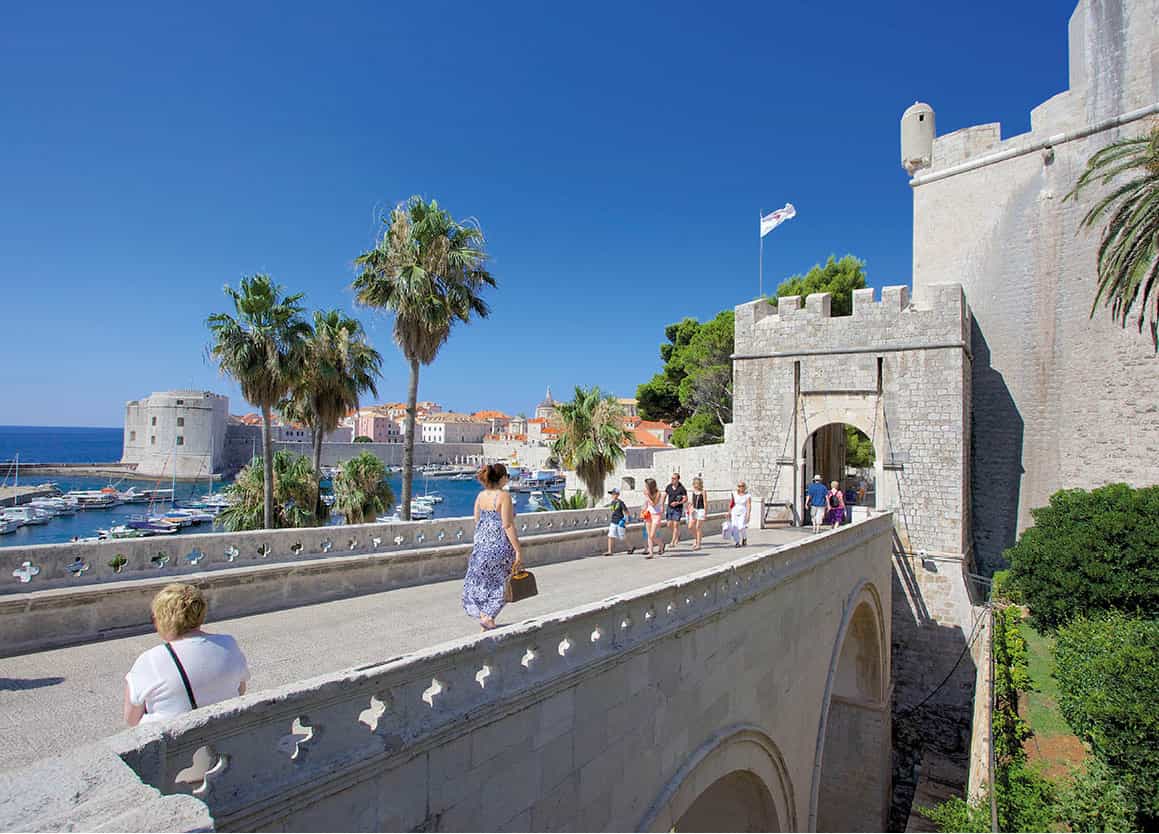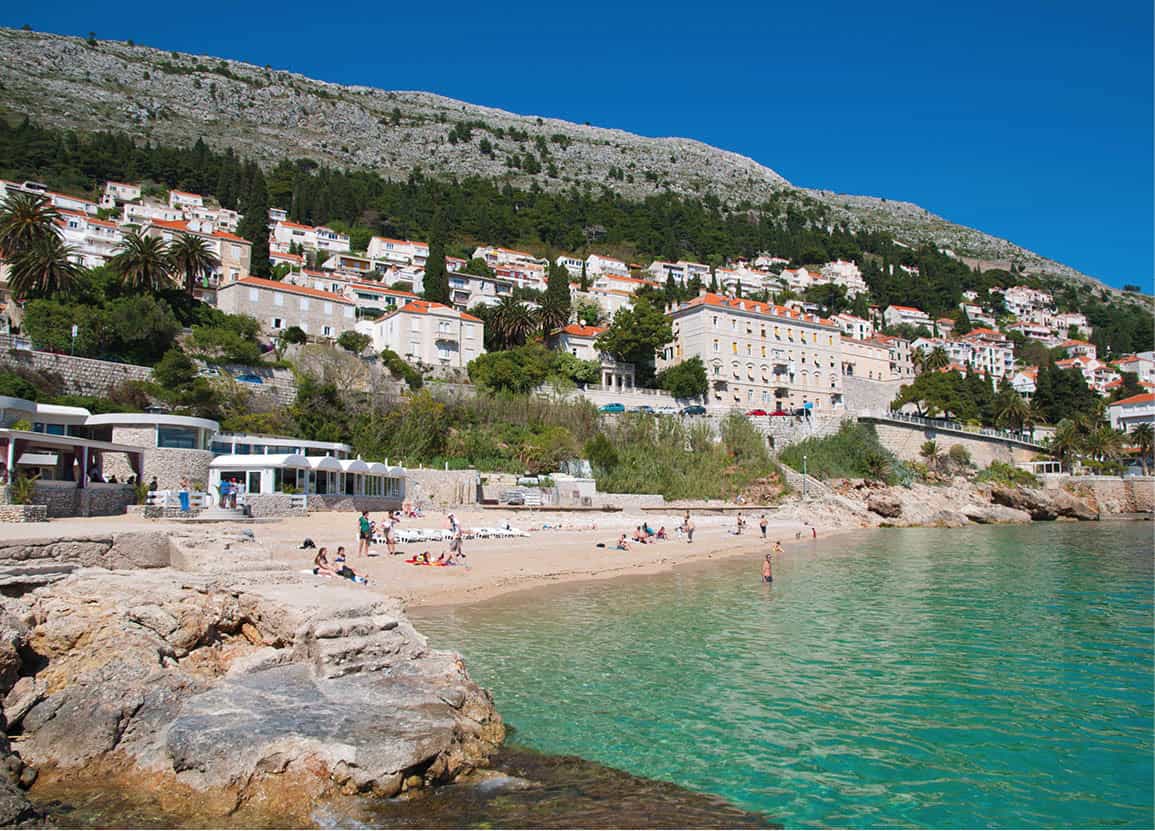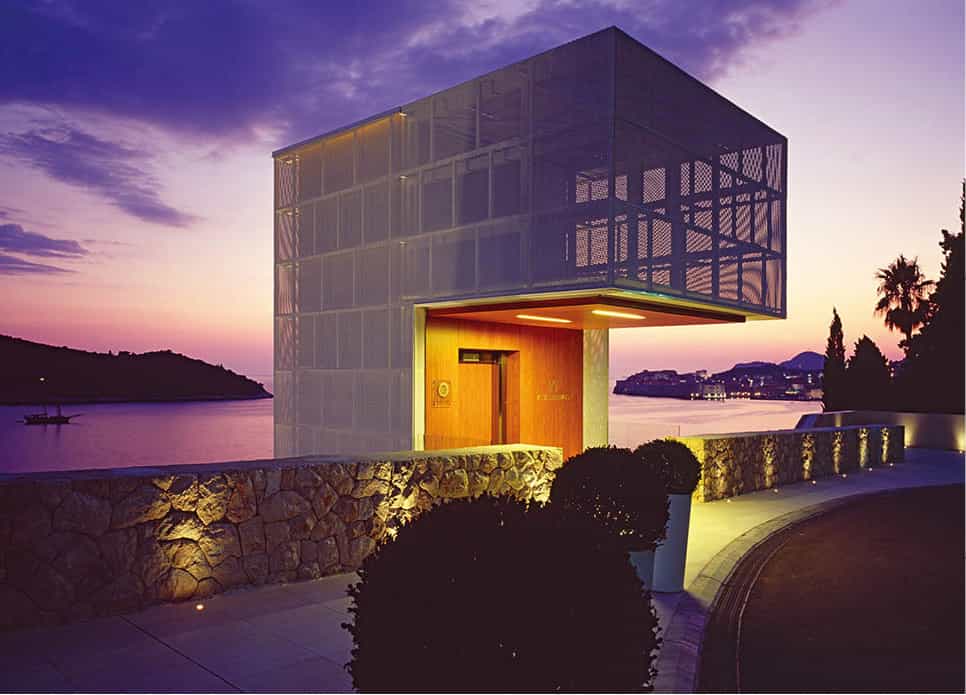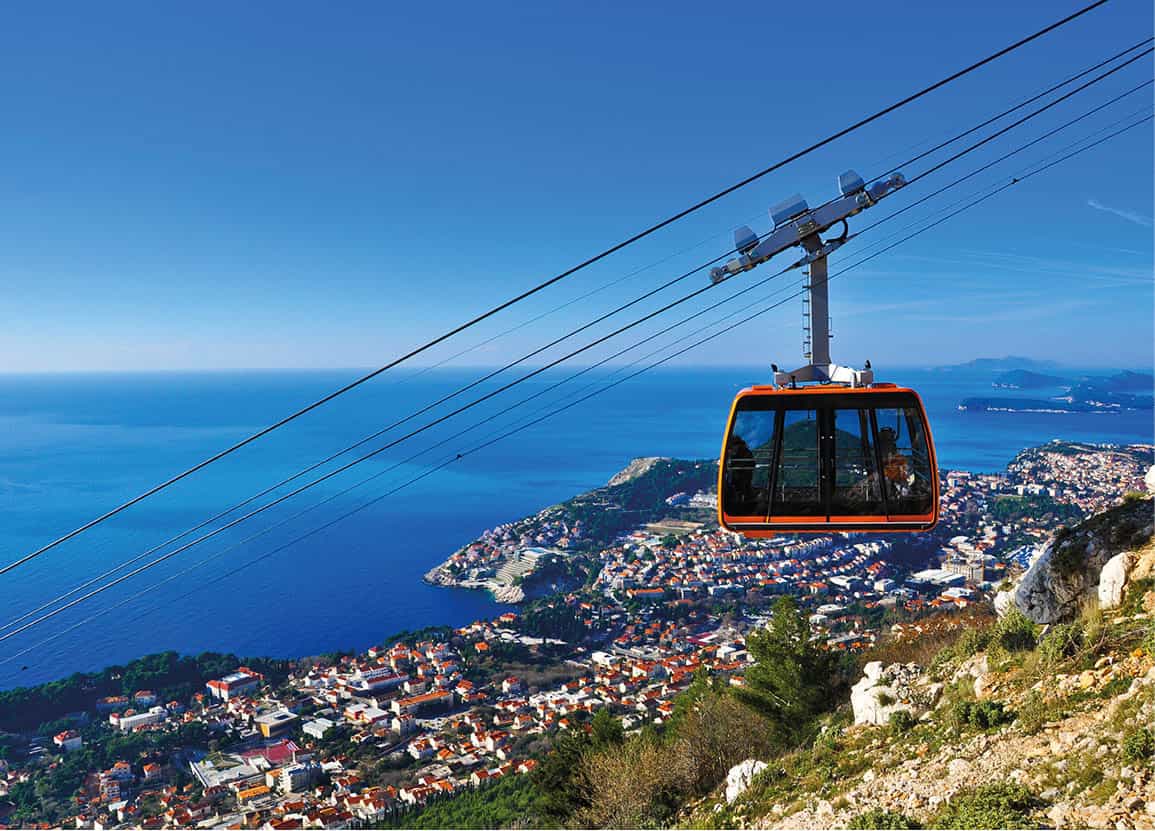Distance: 5km (3 miles)
Time: Half day
Start: Ploče Gate
End: Ploče Gate
Points to note: The walk, with a visit to the museum, can easily be done in two hours, but if you stop for a swim and a drink at one of the beach bars, it could make a satisfying half day out. If you choose to take the cable car to Mount Srđ it will, of course, take more time. There is a longer, more arduous option to hike up Mount Srđ, which is about a 4km (2.5 miles) walk up a zigzagging path and will take more than an hour each way.
In the height of summer, it can be oppressively busy within the City Walls when the cruise ships dock and passengers descend on the Old Town. Escaping the crowds with a stroll along the shore road gives you a different perspective on the city. And a trip up to Mount Srđ rewards you with sweeping views of the coast.

Harbour view from Ploče Gate
Robert Harding
Ploče Gate and Banje Beach
Outside the Ploče Gate 1 [map], there is a drawbridge and outer and inner gates flanked during the summer months by stoical costumed guards and presided over by St Blaise. On the harbour side is the Revelin Club (www.clubrevelin.com), whose terrace tables offer splendid views and are great for a morning coffee or a sunset drink. On the other side looms the bulk of the Revelin Fortress 2 [map] (open Thur–Tues 10am–4pm), built in the 16th century to protect the town against Turkish attacks from the interior. Its ground floor houses two archaeological exhibits showing medieval church furniture as well as displays showing how the fortress was built. Opposite is a small bar, Laura (see 1), which is a handy spot for a drink before or after the walk.
Out on the main road, Frana Supila, the palatial building on your left is a school, as the sounds emanating from inside will tell you. To the right are the walls of the Lazareti 3 [map] (Frana Supila 8; open Thur–Sat 10pm–5am, winter only Fri and Sat; www.lazareti.com), which used to be an old quarantine hospital built in the 17th century to keep disease from the city. Its half-dozen buildings now form Dubrovnik’s premier arts venue spread over three floors and sprawling towards the beach, with a large courtyard tucked within. Local folklore group Linđo often puts on performances here, and the venue features cinema nights when Croatian and international films are projected on the outside walls. It’s also home to a late-night club with appearances by live bands and top DJs from around the world. There are a couple of small galleries at street level, and the cavernous rooms below house textile workshops.
Beside a small post office there are steps leading down to pebbly Banje Beach 4 [map], from which you can water-ski. There is another flight of steps further up, near the Hotel Excelsior. Security guards are on duty at either end, but this is a public beach, so you’re free to pitch a towel wherever you find a space – or preferably a padded beach mat to protect you from the pebbles. The swish Banje Beach Club (www.banjebeach.com) has a cordoned-off section where you can rent canopied loungers if you want a bit of comfort. Because it’s the main beach by the Old Town, it gets unbelievably busy in the summer, but the water stays warm until well into the autumn and is a tranquil place out of season.

Banje Beach, Dubrovnik’s recreational shore
Robert Harding
Museum of Modern Art
Past the beach, on the left-hand side at No. 23, is the Museum of Modern Art 5 [map] (Umjetnička Galerija; Tues–Sun 9am–8pm; http://ugdubrovnik.hr/en). It is housed in a beautiful building that looks pure Renaissance but was actually built in 1935 for a wealthy ship owner. When the doors are closed, it is easy to miss the gallery, as its name is displayed only on a discreet plaque to the left of the entrance. The collection, housed over four floors, with sculptures in the courtyard, is rotated, but invariably includes works by Vlaho Bukovac (1855–1922), who, in 1878, was the first Croatian to be accepted by the Paris Salon. Bukovac was born in Cavtat where more of his work can be seen. Upstairs the collection moves further into the 20th century, and includes works by some of the country’s best-known modern sculptors, Ivan Kožarić, Frano Kršnić and Ivan Meštrović. There are also paintings by Ivo Dulčić and Đuro Pulitika, although many of these are now shown in the gallery opposite the Cathedral. On the third floor the palatial salon and terrace threaten to outshine the exhibits, and the top floor is used for changing exhibitions.

The striking Villa Dubrovnik Hotel
Leonardo
Folly and Philosophy
Almost opposite the gallery is the swanky, recently renovated Hotel Excelsior (www.adriaticluxuryhotels.com), then the inter-linked Villa Orsula and Grand Villa Argentina, where the road divides. Take the lower path, Ulica Vlaha Bukovca, where, in lush gardens, stands an Oriental folly known as the Villa Scheherazade 6 [map], built in the early 20th century for a wealthy banking family. All you see from the road, peering through Mozarabic wrought-iron gates, is the shiny tiled blue dome. But you get an excellent view of the folly from the sea on a boat trip to Lokrum, where it looks like something out of a James Bond film. It used to be a privately owned villa, but it was bought by the Adriatic Luxury Hotels group and offers accommodation at a suitably luxurious price.
Next door, but within the gardens, is a tiny chapel with a bell wall and a plaque on the wall informing passers-by that the mathematician and natural philosopher Marin Getaldić (1568–1626) used to conduct experiments in a cave below. (You can see the cave from the sea or when looking back at the end of this walk.) Local people were extremely wary of Getaldić, convinced that his activities in the cave must have had something to do with witchcraft.
Walking along this narrow road, with cypresses and century plants growing on the seaward side and oleanders in gardens on the left, you feel as if you are in a country lane. There’s little traffic, particularly after you pass the Villa Dubrovnik Hotel (http://www.villa-dubrovnik.hr). A short way along you reach the square-towered former monastery of Sveti Jakov (St Jacob), now a private residence, except for the church, which is open only for mass on Sunday. Follow the path as it winds down behind the monastery. There are great views back to town (and to Getaldić’s cave) and an unmarked flight of steps down to the lovely sheltered beach of Sveti Jakov, which is mainly pebbly with some sandy sections. During the summer there’s a snack bar and restaurant, and you can rent kayaks, pedalos and jet skis.
Nostalgic Corner
Ahead of you is an old wrought-iron gate on which can just be discerned the words ‘Hotel Belvedere’ 7 [map]. Through here, to the left, are the derelict remains of the hotel that suffered so badly in the bombardment of 1991–92. Because it was close to the ridge from which shells and artillery were fired, it stood little chance. A Russian billionaire has bought the ruin to convert it into a luxurious hotel. At present, however, it’s an eerie, atmospheric spot, especially out of season.

Stupendous views from the cable car
iStock
Retrace your steps so that you’re near the Ploče Gate. On your right you’ll see the sign for the Dubrovnik Cable Car 8 [map] (open daily Jun–Aug 9am–midnight, Sep 9am–10pm, Apr and Oct 9am–8pm, Feb, Mar and Nov 9am–5pm, Jan and Dec 9am–4pm; www.dubrovnikcablecar.com). Walk along Ulica Iza Grada, turn right on to Zagrebačka and right again on to Kralja Petra Krešimira IV. (If you are taking the Atlas airport transfer bus (www.atlas-croatia.com) back to the airport, this is where you board for the return journey, not at the Pile Gate.)
The 778m (2,552ft) journey up to Mount Srđ takes only a few minutes, but views along the way are wonderful as the car climbs up to the ridge. At the cable car station at the top, there’s a souvenir shop and the Panorama restaurant. Outside there’s an amphitheatre, which, when it’s not being used for weddings, gives visitors ample room to roam around and take in the views of the Elaphite Islands, Lokrum and a wide swathe of the Dalmatian coastline down below. Behind is a stark ridge of bare brown mountains, which contrast dramatically with the blue of the Adriatic Sea.
Your ticket to the cable includes a visit to the Museum of the Homeland War 9 [map] (daily 8am–until sunset; charge if you don’t have cable car ticket), which is housed in one wing of the remains of Fort Imperial, a Napoleonic fort. The well-documented exhibition is a moving testimony to the suffering and destruction inflicted on the city. There is also a memorial to those who died defending Mount Srđ during the 1991–92 siege of Dubrovnik.
Food and Drink
1 Laura
Frana Supila 1; tel: 098-428 278; open Sun–Thu 6.30–midnight, Fri–Sat 6.30–2am; €
A small ivy-covered terrace makes this corner bar hard to spot, but it’s a favourite place for people who like good music and inexpensive drinks. It gets very lively in the evenings.
